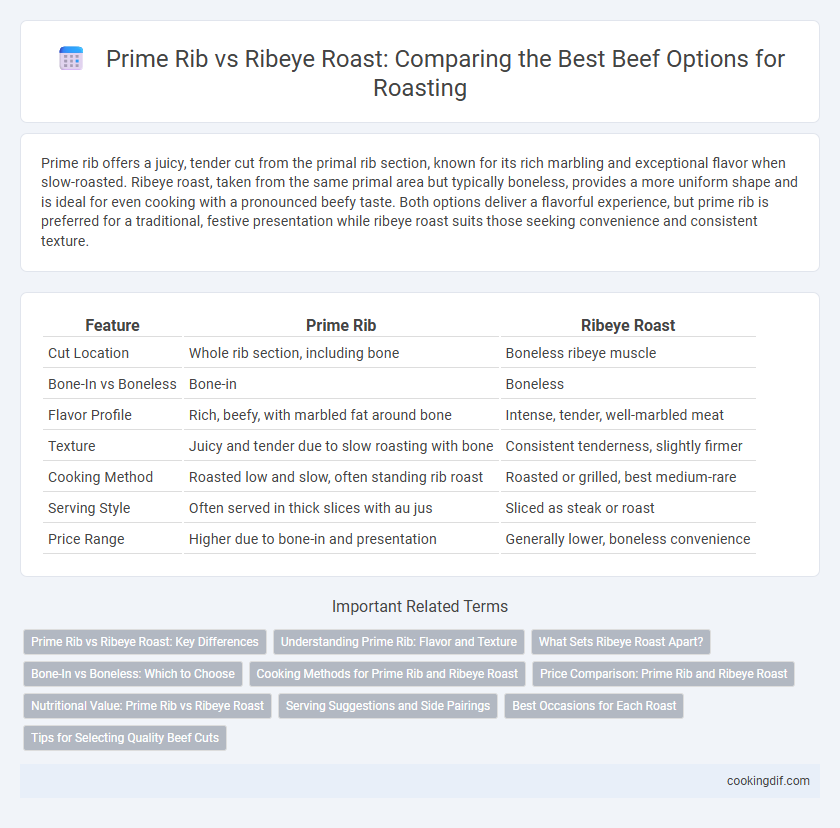Prime rib offers a juicy, tender cut from the primal rib section, known for its rich marbling and exceptional flavor when slow-roasted. Ribeye roast, taken from the same primal area but typically boneless, provides a more uniform shape and is ideal for even cooking with a pronounced beefy taste. Both options deliver a flavorful experience, but prime rib is preferred for a traditional, festive presentation while ribeye roast suits those seeking convenience and consistent texture.
Table of Comparison
| Feature | Prime Rib | Ribeye Roast |
|---|---|---|
| Cut Location | Whole rib section, including bone | Boneless ribeye muscle |
| Bone-In vs Boneless | Bone-in | Boneless |
| Flavor Profile | Rich, beefy, with marbled fat around bone | Intense, tender, well-marbled meat |
| Texture | Juicy and tender due to slow roasting with bone | Consistent tenderness, slightly firmer |
| Cooking Method | Roasted low and slow, often standing rib roast | Roasted or grilled, best medium-rare |
| Serving Style | Often served in thick slices with au jus | Sliced as steak or roast |
| Price Range | Higher due to bone-in and presentation | Generally lower, boneless convenience |
Prime Rib vs Ribeye Roast: Key Differences
Prime rib and ribeye roast both come from the beef rib section but differ in preparation and presentation; prime rib is a standing rib roast typically cooked with the bone in, offering a juicier texture and rich flavor, while ribeye roast is usually boneless, providing easier carving and more even cooking. Prime rib is often roasted at lower temperatures for a longer time to achieve a tender, medium-rare interior, whereas ribeye roast can be cooked faster and is favored for its marbling and concentrated taste. Understanding these distinctions helps in selecting the ideal roast based on desired flavor, texture, and serving style.
Understanding Prime Rib: Flavor and Texture
Prime rib offers a rich, beefy flavor with a tender, juicy texture due to the marbling and the rib roast cut including the bone. The bone-in nature of prime rib enhances moisture retention and imparts deeper flavor during roasting compared to boneless ribeye roast. This cut is prized for its balance of succulence and robust taste, making it a top choice among beef roasts.
What Sets Ribeye Roast Apart?
Ribeye roast stands out for its rich marbling and exceptional tenderness, delivering a flavorful and juicy eating experience compared to prime rib. The ribeye roast comes from the rib section, featuring muscle fibers that are well-marbled with fat, enhancing its succulence and depth of flavor. While prime rib includes the bone and often a thicker fat cap for roasting, ribeye roast is typically boneless, making it easier to carve and ideal for precise, even cooking.
Bone-In vs Boneless: Which to Choose
Prime rib roast is typically bone-in, offering enhanced flavor and moisture retention due to the marrow and structure of the bones, while ribeye roast is often boneless, providing easier carving and uniform cooking. Bone-in roasts tend to have more intense beef flavor and juiciness, whereas boneless cuts allow for quicker cooking times and versatile seasoning. The choice depends on preference for richer taste and presentation versus convenience and precise portioning.
Cooking Methods for Prime Rib and Ribeye Roast
Prime rib is traditionally slow-roasted at low temperatures to retain juiciness and tenderness, often finished with high heat for a flavorful crust. Ribeye roast is typically cooked using dry heat methods like roasting or grilling to enhance its marbling and rich beef flavor. Both cuts benefit from resting after cooking to allow juices to redistribute, ensuring a moist and flavorful roast.
Price Comparison: Prime Rib and Ribeye Roast
Prime rib is generally more expensive than ribeye roast due to its premium quality and popularity during holidays and special occasions. Ribeye roast offers a more affordable alternative with similar marbling and tenderness, making it a cost-effective choice for everyday meals. Price fluctuations can occur based on regional availability, butcher selection, and the cut's size and grade.
Nutritional Value: Prime Rib vs Ribeye Roast
Prime rib and ribeye roast both offer rich nutritional profiles, with prime rib typically containing slightly higher fat content due to the rib cap marbling, which enhances flavor and calorie density. Ribeye roast provides a balance of protein and fat, making it a nutrient-dense option with approximately 28 grams of protein and 20 grams of fat per 3-ounce serving. Both cuts are excellent sources of iron, zinc, and B vitamins, essential for muscle health and energy metabolism.
Serving Suggestions and Side Pairings
Prime rib offers a tender, flavorful roast ideal for slicing and serving with classic horseradish sauce and au jus, pairing well with garlic mashed potatoes and roasted root vegetables. Ribeye roast, known for its marbling and rich taste, serves beautifully as thick, juicy steaks accompanied by creamed spinach and a robust red wine reduction. Both cuts complement herb-infused roasted carrots and a fresh arugula salad, enhancing the beef's savory profile and providing balanced textures.
Best Occasions for Each Roast
Prime rib roast is ideal for festive gatherings and large celebrations due to its impressive size and tender, flavorful meat that serves multiple guests. Ribeye roast suits intimate dinners or casual meals where its rich marbling and robust flavor can be appreciated in smaller portions. Choosing between prime rib and ribeye roast depends on the occasion's scale and desired presentation, balancing between grandeur and informal elegance.
Tips for Selecting Quality Beef Cuts
When selecting prime rib or ribeye roast, prioritize marbling and uniform color, which indicate flavor and tenderness. Look for cuts with firm texture and avoid any discoloration or dry spots, ensuring freshness and optimal roasting results. Choosing USDA Prime or Choice grades guarantees better quality and juiciness for a superior beef roast experience.
Prime rib vs ribeye roast for beef options Infographic

 cookingdif.com
cookingdif.com